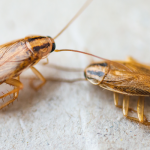
When it comes to protecting your family and home against pests, hindsight doesn’t have to be 20/20 this year. Terminix Anderson is helping homeowners prepare for the upcoming pest season by offering insights into anticipated pest activity.
The experts at Terminix Anderson have examined trends and used their field experiences and company data to determine these six pest predictions. In addition to these predictions, we are offering preventative tips for homeowners to help keep their homes pest-free in 2020.
Mice
Mice populations have increased over the past several years and their activity may be attributed to warmer than usual winters. With warmer weather predicted again this winter, mice populations may boom, which is bad news for homeowners. Mice are year-round pests that invade homes looking for two things: food and shelter.
Homeowner Tips: Mice can fit through a crack or hole one-fourth of an inch or larger – or about the width of a pencil. To prevent an infestation, seal small cracks and crevices with a silicone-based caulk. Exterior gaps of ¼-inch or larger can be repaired with copper mesh, hardware cloth or metal flashing.
Stinging Pests
Changes in climate can cause rippling effects in the pest world, and with mild winters, experts are seeing more hornet and yellow jacket nests. Female yellow jackets and hornets are able to overwinter, even in freezing temperatures. These stinging insects will invade homes, structures, and man-made or natural voids. When temperatures rise in spring, stinging insects will surface from their hiding places, ready to start populations earlier in the year.
Homeowner Tips: Hornets and yellow jackets can overwinter, so at the first sign of warm weather, they may be out and about. Be on the lookout for stinging pests, utilizing a professional pest control service as soon as you spot activity.
Ticks
With outdoor activities, like hiking and camping on the rise, and years of warming winters, humans and their pets may come into contact with ticks more frequently in 2020. The deer tick or black-legged tick, the Lone Star tick, and the American dog tick are ticks of special concern. Nearly 50,000 cases of human tick-borne diseases such as Lyme Disease, Ehrlichiosis, and Rocky Mountain Spotted Fever were reported in 2018. Pets are also at risk for some of these diseases.
Homeowner Tips: If you spend time outdoors, wear an EPA-approved insect repellent. It’s also a good idea to wear long pants, long-sleeved shirts, and socks, in areas where ticks may be active. Perform tick checks on yourself and any family members, including pets, after spending time outdoors.
Mosquitoes
Mosquitoes thrive in warm weather, and their populations increased in 2019. If we have another relatively warm, wet winter and spring, we could experience another boom inactivity by late spring and early summer. Areas of the Mid-Atlantic and Midwest are predicted to have above-average rainfall, while most of the U.S. is predicted to be warmer than average this winter.
Homeowner Tips: The risk of mosquito-borne diseases, such as the Eastern Equine Encephalitis (EEE) can increase with rising populations. To protect yourself and your family, dispose of standing water from your property and always wear an EPA-approved insect repellent when spending time outdoors.
Termites
Termites are the most destructive pests in North America, causing over $6 billion in property damage each year. According to experts, the two main weather factors that affect termite populations are temperature and rainfall. With warmer and wetter weather predicted for spring, the termite swarming season will be ramping up soon.
Homeowner Tips: To deter termites, eliminate earth to wood contact and avoid moisture accumulation near your home or structures’ foundation. Since termites can cause such extensive damage, raising homeowner awareness around the need for proactive protection for their homes is critical to prevent costly repairs.
The experts at Terminix Anderson agree that the first step any homeowner can take to prevent pest issues is to be proactive. With these pest predictions in mind, take some time to evaluate your current pest control plan and ensure that you have the coverage you need to protect yourself and your family from pests this year.





